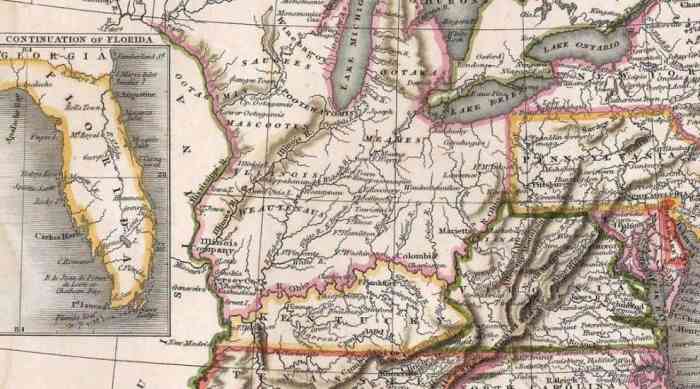Unveiling the Land Ordinance of 1785 Map, a pivotal document that shaped the very fabric of American land ownership, we embark on a journey through history, exploration, and the profound impact on westward expansion. This meticulously crafted map, with its rectangular survey system, not only divided land but also shaped the destiny of a nation.
The Land Ordinance of 1785 established a standardized method for surveying and dividing public lands into townships and sections, creating an orderly system that facilitated land distribution and settlement. This ordinance played a crucial role in shaping land ownership patterns and influenced the development of communities and states across the United States.
Overview of the Land Ordinance of 1785
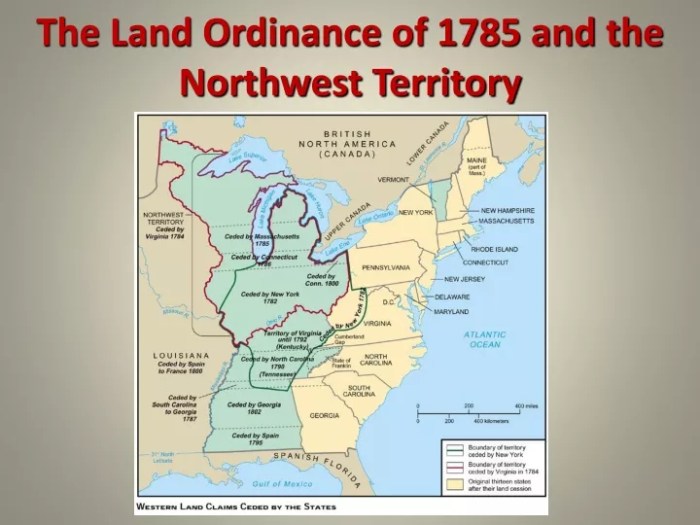
The Land Ordinance of 1785 was a landmark piece of legislation enacted by the Confederation Congress of the United States. It established a comprehensive system for surveying and selling public lands in the newly acquired western territories. The ordinance had a profound impact on the development of the United States, shaping the settlement patterns, land ownership, and economic growth of the nation.
Establishment of the Rectangular Survey System, Land ordinance of 1785 map
One of the most significant provisions of the Land Ordinance of 1785 was the establishment of the rectangular survey system. This system divided public lands into townships, each measuring six miles square and containing 36 sections of one square mile (640 acres) each.
The townships were further subdivided into quarters and half-quarters, creating a grid-like pattern that facilitated land measurement, mapping, and record-keeping.
The rectangular survey system provided a standardized and efficient method for surveying and selling public lands. It ensured that land parcels were of uniform size and shape, making it easier for settlers to identify and claim their property. The system also allowed for the creation of accurate maps and land records, which were essential for land management and taxation purposes.
Map of the Rectangular Survey System
[Image of a map illustrating the rectangular survey system, with townships, sections, and quarter-sections labeled.]
The map shows the rectangular survey system applied to a portion of the Northwest Territory. The townships are labeled with numbers, and the sections within each township are labeled with letters. This system allowed for the precise identification and location of land parcels, making it easier for settlers to claim and develop their land.
Impact on Land Distribution
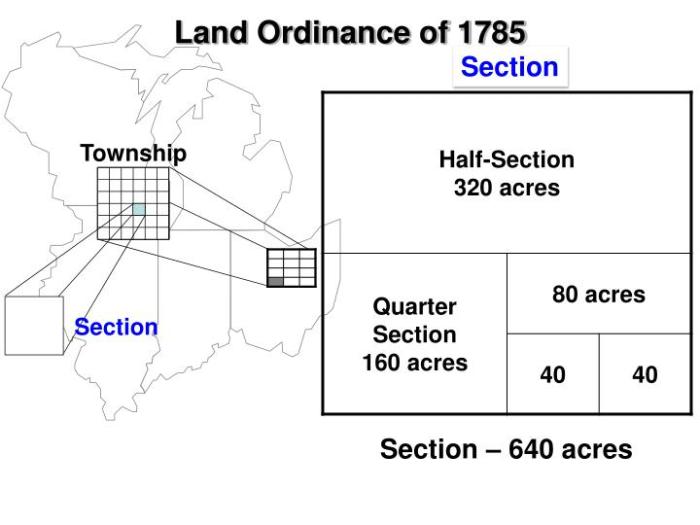
The Land Ordinance of 1785 had a significant impact on land distribution and settlement patterns in the United States. It established a systematic method for surveying and dividing land in the Northwest Territory, which helped to organize and facilitate the westward expansion of the country.
Townships and Sections
The ordinance divided the land into townships, each measuring six miles square (36 square miles). Townships were further subdivided into 36 sections, each one mile square (640 acres). This system created a grid-like pattern of land ownership that made it easy to identify and describe land parcels.
- The township and section system provided a standardized and organized way to divide and distribute land in the Northwest Territory.
- It simplified the process of land ownership and transfer, as each section could be easily identified and located.
- The system also helped to prevent land disputes and conflicts by clearly defining the boundaries of each property.
Role in Western Expansion
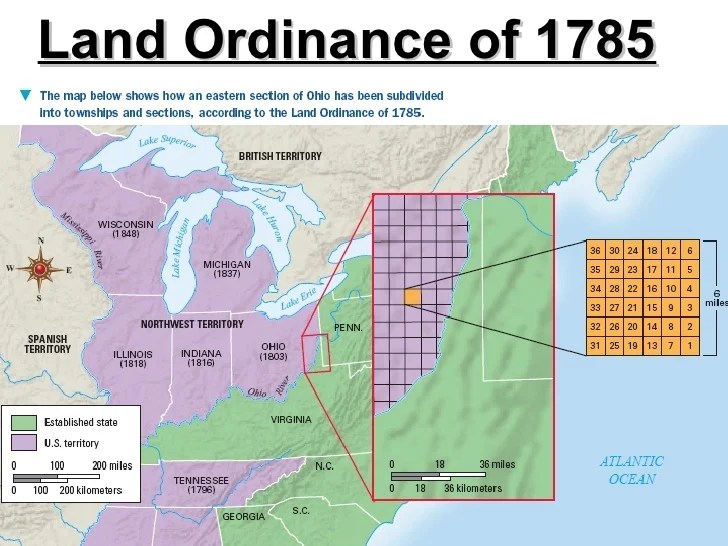
The Land Ordinance of 1785 played a pivotal role in facilitating westward expansion by establishing a systematic process for surveying and selling land in the Northwest Territory.
Surveying and Selling Land
The ordinance mandated the creation of townships, each six miles square and divided into 36 sections of one square mile each. This standardized system of land division allowed for the orderly and efficient surveying and sale of land.
Land was sold in a series of auctions, with the minimum price set at $1 per acre. The revenue generated from these sales was used to fund the federal government and support the development of the Northwest Territory.
Impact on Native American Land Rights
The Land Ordinance of 1785 had a significant impact on Native American land rights. By establishing a legal framework for the sale of land in the Northwest Territory, the ordinance undermined Native American claims to the land and paved the way for the dispossession of Native American tribes.
The Land Ordinance of 1785 established a rectangular survey system for the public lands of the United States. This system divided the land into townships six miles square, each of which was further subdivided into 36 sections one mile square.
Freak the Mighty Iggy Lee is a novel by Rodman Philbrick that tells the story of two friends, Max and Freak, who live in a small town in the Midwest. The novel explores themes of friendship, disability, and coming of age.
The Land Ordinance of 1785 played a role in the settlement of the Midwest, and it continues to shape the landscape of the region today.
Native American tribes had traditionally held land communally, but the ordinance imposed a system of individual ownership that was foreign to their culture. This led to conflicts between Native American tribes and settlers, as the tribes struggled to defend their land rights against the encroaching tide of westward expansion.
Historical Significance: Land Ordinance Of 1785 Map
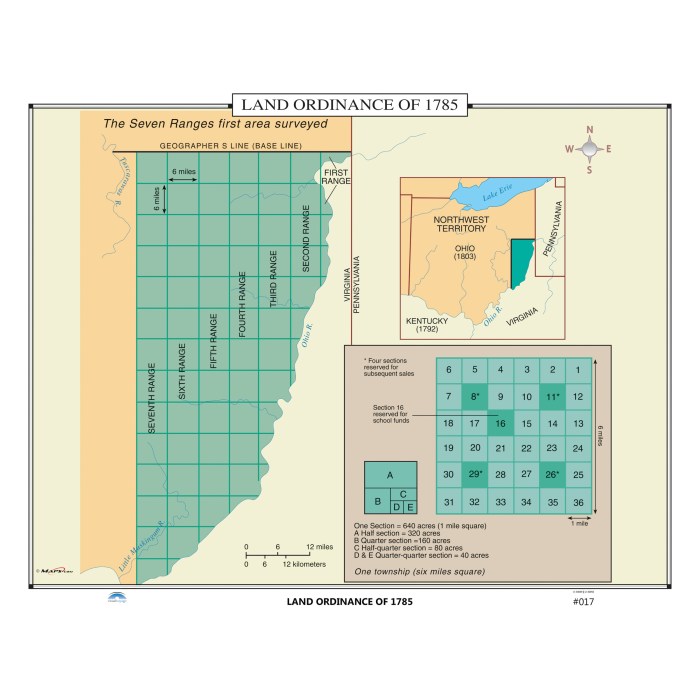
The Land Ordinance of 1785 emerged from a long history of land ownership policies in the American colonies and the newly formed United States.
Prior to the ordinance, land ownership in the colonies was largely determined by royal charters and grants, with large tracts of land being granted to individuals and companies. This system often led to speculation and unequal distribution of land.
Evolution of Land Ownership Policies
- Colonial Era:Royal charters and grants dominated land ownership, with large tracts given to individuals and companies.
- Articles of Confederation:States retained control over land within their borders, leading to inconsistencies and disputes.
- Land Ordinance of 1785:Established a systematic method for surveying and selling public lands, promoting equitable distribution.
Questions Often Asked
What was the primary purpose of the Land Ordinance of 1785?
To establish a standardized system for surveying and distributing public lands in the Northwest Territory.
How did the rectangular survey system impact land ownership?
It created an orderly system of townships and sections, facilitating the sale and settlement of land.
What role did the Land Ordinance of 1785 play in westward expansion?
It provided a framework for surveying and selling land in the Northwest Territory, paving the way for settlement and economic development.
